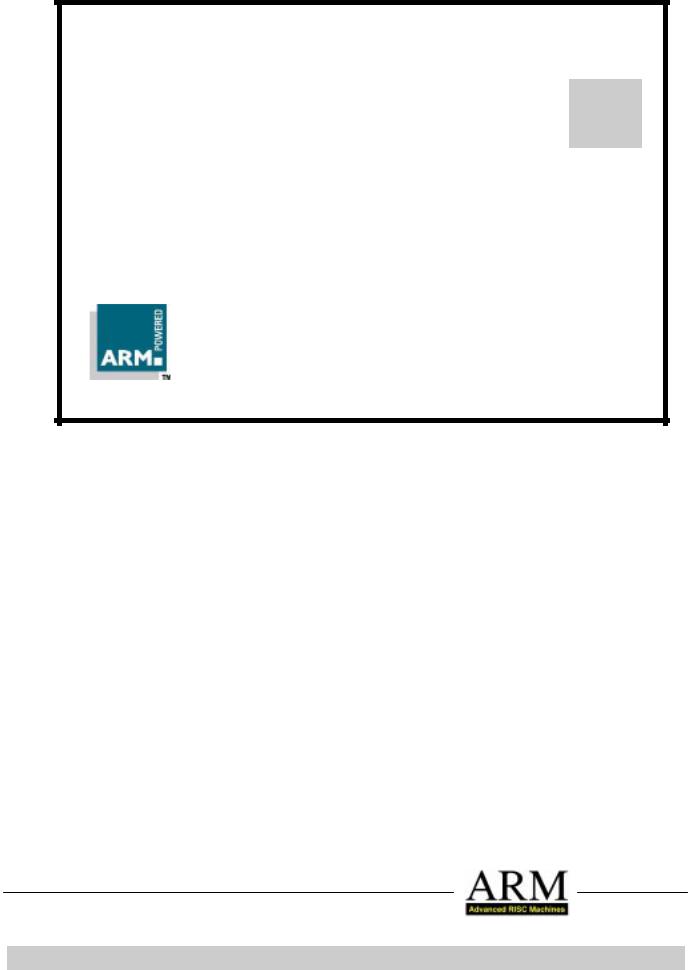
(ARM).Big and little endian byte addressing
.pdf
Application Note 61
Big and Little Endian Byte Addressing
Document number: ARM DAI 0061A
Issued: March 1998
Copyright Advanced RISC Machines Ltd (ARM) 1998
ENGLAND |
|
|
GERMANY |
|
||
Advanced RISC Machines Limited |
Advanced RISC Machines Limited |
|||||
Fulbourn Road |
|
|
Otto-Hahn Str. 13b |
|
||
Cherry Hinton |
|
|
85521 Ottobrunn-Riemerling |
|||
Cambridge CB1 4JN |
|
Munich |
|
|
||
UK |
|
|
|
Germany |
|
|
Telephone: |
+44 |
1223 400400 |
Telephone: |
+49 89 608 75545 |
||
Facsimile: |
+44 |
1223 400410 |
Facsimile: |
+49 89 608 75599 |
||
Email: |
info@arm.com |
Email: |
info@arm.com |
|||
JAPAN |
|
|
|
USA |
|
|
Advanced RISC Machines K.K. |
ARM USA Incorporated |
|||||
KSP West Bldg, 3F 300D, 3-2-1 Sakado |
Suite 5 |
|
|
|||
Takatsu-ku, Kawasaki-shi |
985 University Avenue |
|||||
Kanagawa |
|
|
Los Gatos |
|
||
213 Japan |
|
|
CA 95030 USA |
|
||
Telephone: |
+81 |
44 850 1301 |
Telephone: |
+1 408 399 5199 |
||
Facsimile: |
+81 |
44 850 1308 |
Facsimile: |
+1 408 399 8854 |
||
Email: |
info@arm.com |
Email: |
info@arm.com |
|||
World Wide Web address: http://www.arm.com
Open Access

Proprietary Notice
ARM and the ARM Powered logo are trademarks of Advanced RISC Machines Ltd.
Neither the whole nor any part of the information contained in, or the product described in, this document may be adapted or reproduced in any material form except with the prior written permission of the copyright holder.
The product described in this document is subject to continuous developments and improvements. All particulars of the product and its use contained in this document are given by ARM in good faith. However, all warranties implied or expressed, including but not limited to implied warranties or merchantability, or fitness for purpose, are excluded.
This document is intended only to assist the reader in the use of the product. ARM Ltd shall not be liable for any loss or damage arising from the use of any information in this document, or any error or omission in such information, or any incorrect use of the product.
Key
Document Number
This document has a number which identifies it uniquely. The number is displayed on the front page and at the foot of each subsequent page.
ARM |
XXX |
0000 |
X |
- 00 |
(On review drafts only) Two-digit draft number
Release code in the range A-Z
Unique four-digit number
Document type
Document Status
The document’s status is displayed in a banner at the bottom of each page. This describes the document’s confidentiality and its information status.
Confidentiality status is one of:
ARM Confidential |
Distributable to ARM staff and NDA signatories only |
Named Partner Confidential |
Distributable to the above and to the staff of named partner companies only |
Partner Confidential |
Distributable within ARM and to staff of all partner companies |
Open Access |
No restriction on distribution |
Information status is one of: |
|
Advance |
Information on a potential product |
Preliminary |
Current information on a product under development |
Final |
Complete information on a developed product |
Change Log
Issue |
Date |
By |
Change |
A |
March 1998 |
SKW |
Released |
|
Application Note 61 |
ii |
ARM DAI 0061A |
Open Access

Table of Contents
Table of Contents
1 |
Introduction |
2 |
|
2 |
Configuring the Endianness of the ARM |
3 |
|
3 |
Effect of Endian Configuration on the System |
4 |
|
|
3.1 |
Connection to memory |
4 |
|
3.2 |
Word accesses to memory |
4 |
|
3.3 |
Byte and halfword accesses to memory |
5 |
4 |
Little-Endian Operation |
7 |
|
|
4.1 |
Connection to memory |
7 |
|
4.2 |
Word accesses to memory |
7 |
|
4.3 |
Byte and halfword accesses to memory |
8 |
5 |
Big-Endian Operation |
9 |
|
|
5.1 |
Connection to memory |
9 |
|
5.2 |
Word accesses to memory |
9 |
|
5.3 |
Byte and halfword accesses to memory. |
10 |
Application Note 61
ARM DAI 0061A |
1 |
Open Access

Introduction
1 Introduction
The term endianness refers to the way in which multiple elements of identical size are stored in memory. There are two conventions for storing bytes within multi-byte quantities, such as 32-bit words, in byte-addressed memory. In a little-endian architecture, the least significant byte of the quantity is stored at the lowest memory address in the range of addresses used to store the quantity. The reverse is true in a big-endian architecture, where the most significant byte is stored at the lowest address.
The ARM can be configured to be either littleor big-endian. This Application Note discusses the effect that choosing either littleor big-endian configuration has on byte and halfword addressing.
For more information on endianness, please see:
∙Computer Architecture - A Quantitive Approach, Henessey & Patterson, page 73, 2nd Ed, Publisher: Morgan Kaufman, ISBN: 1-55860-32908.
∙ARM System Architecture, Steve Furber, page 110, 1st Ed, Publisher: Addison-Wesley, ISBN 0-201-40352-8.
Note The basic endian configuration principles described in this application note are applicable to all ARM cores and AMBA-based systems. However, the signal names used are specific to ARM7TDMI. For equivalent signal names for other ARM cores, or AMBA-based systems, please refer to the appropriate datasheet.
|
Application Note 61 |
2 |
ARM DAI 0061A |
Open Access

Configuring the Endianness of the ARM
2 Configuring the Endianness of the ARM
The endian configuration of the ARM is controlled by the BIGEND signal to the core. This configures the byte and halfword extraction logic in the processor to extract the addressed data appropriately when accessing sub-word quantities. Tying this HIGH causes the ARM to operate in big-endian mode. Tying it LOW causes the ARM to operate in little-endian mode.
However, some ARM designs do not have the BIGEND signal accessible externally and instead the endianness of the ARM is controlled by the ARM MMU (coprocessor 15). For more information on how to control the endianness of such ARMs see Application Note 37: Startup Configuration of ARM Processors with MMUs (ARM DAI 0037).
Once you have configured your system’s endianness, any application code built to run on that system must be built to match. To do this, use the compiler/assembler options -li (for a little-endian application¾the default) or -bi (for a big-endian application) as appropriate. In addition, if you link with a standard ARM ANSI C library, this also needs to be of the same endianness.
Big-endian libraries have the extension .32b (ARM) or .16b (Thumb). Little-endian libraries have the extension .32l (ARM) or .16l (Thumb).
Note The last character in the extension for a little-endian library is the letter l.
When code is loaded into an ARM debugger, the debugger must also be instructed which endian configuration the system is in. With armsd this is done using the -li (default) or - bi option as appropriate. In the ARM Debugger for Windows, it is done in the Options- >Configure Debugger dialog box.
Note The ARM Software Development toolkit does not support dynamic endian configuration. The whole application code must be built either as bigor as little-endian. An application cannot be built as a combination of the two, nor can it change the endianness of the system during normal execution.
Application Note 61
ARM DAI 0061A |
3 |
Open Access

Effect of Endian Configuration on the System
3 |
Effect of Endian Configuration on the System |
||
3.1 Connection to memory |
|
||
|
The endian configuration of your system determines how you should connect the memory |
||
|
up to the ARM. If you do not connect memory up to match the configuration of BIGEND, |
||
|
byte and halfword accesses (including Thumb instructions fetches) will not behave as |
||
|
predicted. |
|
|
|
For narrow memory subsystems (that is, 8 or 16 bits wide) the bytes must always be |
||
|
presented to the correct byte lanes on the 32-bit microprocessor core. |
||
|
Also note that separate byte write enables must be provided to the memory (you should |
||
|
not utilize 32-bit wide, on-chip memory with only a single write-enable control for the whole |
||
|
word). |
|
|
|
See 4.1 Connection to memory on page 7 for details of how to connect memory in a |
||
|
little-endian system. See 5.1 Connection to memory on page 9 for details of how to |
||
|
connect memory in a big-endian system. |
||
3.2 Word accesses to memory |
|
||
|
Unaligned word stores are effectively truncated to word-aligned addresses, such that the |
||
|
bottom two bits of the address are equal to zero. Thus word stores are always made to |
||
|
word-aligned addresses. This means that bit 31 of the register being stored always |
||
|
appears on D[31]. |
|
|
|
With aligned word loads, D[31] is always loaded into bit 31 of the register being loaded. |
||
|
However, word loads from unaligned addresses load data from memory in a way that |
||
|
depends upon the endian configuration of the system and the offset from the truncated |
||
|
word-aligned address. |
|
|
|
The following code can be used to see the effect of unaligned word loads: |
||
|
AREA unalign, CODE, READONLY |
||
|
ENTRY |
|
|
|
MOV r2, #0xF000 |
|
|
|
LDR r3, =0x7654321 |
|
|
|
STR r3, [r2] |
; store the word |
|
|
LDR r4, [r2] |
; read word back - aligned |
|
|
LDR r5, [r2,#1] |
; read word - unaligned - offset 1 |
|
|
LDR r6, [r2,#2] |
; read word - unaligned - offset 2 |
|
|
LDR r7, [r2,#3] |
; read word - unaligned - offset 3 |
|
|
exit |
|
|
|
MOV |
r0, #0x18 |
; angel_SWIreason_ReportException |
|
LDR |
r1, =0x20026 |
; ADP_Stopped_ApplicationExit |
|
SWI |
0x123456 |
; Angel semihosting ARM SWI |
|
END |
|
|
|
Application Note 61 |
4 |
ARM DAI 0061A |
Open Access

Effect of Endian Configuration on the System
Note that the ARM compilers sometimes make use of unaligned loads. For instance, an unaligned load can be used to load a short into the top 16 bits of a register. This can then be shifted down into the bottom 16 bits using an LSR operation which automatically clears the top 16 bits to zero (as required). This could occur in situations where there is no direct halfword support on a core, or where the halfword is in a packed struct and occupies the middle two bytes of the word.
It is possible to disable this feature using the compiler option -za1.
If you do not want to allow unaligned word accesses, the memory controller would be normally be responsible for generating the fault (typically a data abort). However this is not usually a sensible thing to do. This is because when the ARM is fetching instructions, A[1:0] (for ARM code) or A[0] (for Thumb code) may hold any value, so it is quite likely that instruction fetches may appear not to be correctly aligned. Therefore if this type of fault is generated, it must only be generated during data transfers.
This adds complexity to the memory controller(s), as they now need to decode A[1:0], MAS[1:0] (or nBW on cores which do not support halfword load/store instructions), and nOPC, to generate an abort. If you want to do this on loads only, you must use nRW as well (although if you generate such faults you should strictly fault reads and writes).
On ARM designs with an ARM MMU (coprocessor 15) the faulting of misaligned word accesses can also be caused by the MMU. This feature can be turned on by MMU coproc control register, bit ‘1’ (‘A’).
See 4.2 Word accesses to memory on page 7 for details of word accesses to memory in a little-endian system. See 5.2 Word accesses to memory on page 9 for details of word accesses to memory in a big-endian system.
3.3 Byte and halfword accesses to memory
When the ARM stores a byte quantity to memory, it outputs the same byte across all four byte lanes. The memory controller must therefore decode A[1:0] appropriately and latch it into the correct byte lane of your memory system. This also applies with halfword stores, with the halfword being output across both halves of the data bus.
For details of the required decoding see 4.1 Connection to memory on page 7 for littleendian systems and 5.1 Connection to memory on page 9 for big-endian systems.
For byte reads, the ARM expects to read the data from byte lane 0 for a word-aligned address, byte lane 1 for an offset of 1 and so on. For halfword reads, the ARM expects to read the data from byte lanes 0 and 1 for a word-aligned address, and byte lanes 2 and 3 for a read offset by 2.
Note The affect of unaligned halfword load and store instructions is unpredictable. The results of such instructions should not be relied upon and they should therefore be avoided.
If the ARM core being used is Thumb-compatible, the way that Thumb instructions will be fetched from memory is also controlled by the endianness of the system. The addressed halfwords are always accessed in sequential low-halfword, high-halfword order.
Application Note 61
ARM DAI 0061A |
5 |
Open Access

Effect of Endian Configuration on the System
The following code can be used to see the effect of byte and halfword accesses:
AREA subword, CODE, READONLY |
|
||||
ENTRY |
|
|
|
|
|
MOV r2, #0xF000 |
; |
address to store word |
|||
LDR r3, =0x76543210 ; |
value to store |
||||
STR r3, [r2] |
; |
store the |
word |
||
LDR r4, [r2] |
; |
read word |
back |
||
LDRB r5, |
[r2] |
; |
read byte |
0 |
|
LDRB r6, |
[r2,#1] |
; |
read byte |
1 |
|
LDRB r7, |
[r2,#2] |
; |
read byte |
2 |
|
LDRB r8, |
[r2,#3] |
; |
read byte |
3 |
|
LDRH r9, |
[r2,#0] |
; |
read halfword |
||
LDRH r10,[r2,#2] |
; |
read halfword |
|||
exit |
|
|
|
|
|
MOV |
r0, |
#0x18 |
; angel_SWIreason_ReportException |
||
LDR |
r1, |
=0x20026 |
; ADP_Stopped_ApplicationExit |
||
SWI |
0x123456 |
; Angel semihosting ARM SWI |
|||
END |
|
|
|
|
|
|
Application Note 61 |
6 |
ARM DAI 0061A |
Open Access

Little-Endian Operation
4 Little-Endian Operation
4.1 Connection to memory
A little-endian configured ARM should be connected to memory as follows:
∙Byte 0 of the memory connected to D[7:0]
∙Byte 1 of the memory connected to D[15:8]
∙Byte 2 of the memory connected to D[23:16]
∙Byte 3 of the memory connected to D[31:24]
The byte write enables are decoded:
nRW |
|
MAS[1:0] |
|
A[1:0] |
|
we31to24 |
|
we23to16 |
|
we15to8 |
|
we7to0 |
0 |
? ? |
? ? |
0 |
0 |
0 |
0 |
||||||
|
|
|
|
|
|
|
||||||
1 |
0 0 |
0 0 |
0 |
0 |
0 |
1 |
||||||
|
|
|
|
|
|
|
||||||
1 |
0 0 |
0 1 |
0 |
0 |
1 |
0 |
||||||
|
|
|
|
|
|
|
||||||
1 |
0 0 |
1 0 |
0 |
1 |
0 |
0 |
||||||
|
|
|
|
|
|
|
||||||
1 |
0 0 |
1 1 |
1 |
0 |
0 |
0 |
||||||
|
|
|
|
|
|
|
||||||
1 |
0 1 |
0 ? |
0 |
0 |
1 |
1 |
||||||
|
|
|
|
|
|
|
||||||
1 |
0 1 |
1 ? |
1 |
1 |
0 |
0 |
||||||
|
|
|
|
|
|
|
||||||
1 |
1 0 |
? ? |
1 |
1 |
1 |
1 |
||||||
|
|
|
|
|
|
|
|
|
||||
1 |
1 1 |
? ? |
|
---------------------------- |
|
Reserved ---------------------------- |
|
|
||||
|
|
|
|
|
|
|
|
|
|
|
|
|
Note During halfword and byte transfers, the address bits marked ‘?’ should be ignored.
4.2 Word accesses to memory
In a little-endian system a LDR from a non-word-aligned address causes the data to be rotated into the register so that the addressed byte occupies bits 0−7 of the register.
Pictorially, if you have an aligned word in memory:
|
Databus |
31−24 |
|
|
23−16 |
15−8 |
7−0 |
|
|
Byte |
|
|
|
|
|
|
|
|
3 |
2 |
1 |
0 |
||||
|
Value |
|
|
|
|
|
|
|
|
76 |
54 |
32 |
10 |
||||
Loading this in at each possible offset gives: |
|
|
|
|
|
|
||
|
|
|
|
|
|
|||
|
|
Load offset |
|
|
Register contents |
|||
|
|
|
|
|
|
|
|
|
|
|
0x0 |
|
|
|
0x76543210 |
|
|
|
|
|
|
|
|
|
|
|
|
|
0x1 |
|
|
|
0x10765432 |
|
|
|
|
|
|
|
|
|
|
|
|
|
0x2 |
|
|
|
0x32107654 |
|
|
|
|
|
|
|
|
|
|
|
|
|
0x3 |
|
|
|
0x54321076 |
|
|
|
|
|
|
|
|
|
|
|
The situation with STRs is simpler, as bit 31 of the register being stored always appears on databus output 31.
Application Note 61
ARM DAI 0061A |
7 |
Open Access

Little-Endian Operation
This can be seen by building and running the program given in 3.2 Word accesses to memory on page 4. Upon program completion, registers r4 to r7 can be seen to contain the values given above.
armasm -li word.s armlink word.o -o word armsd -li word
A.R.M. Source-level Debugger vsn 4.48 (Advanced RISC Machines SDT 2.11)
[Sep |
9 |
1997] |
|
|
|
|
|
|
|
ARMulator 2.02 [Sep |
9 |
1997] |
|
|
|
|
|
||
ARM7TDM, 4GB, Dummy |
MMU, Soft Angel 1.4 [Angel SWIs, Demon SWIs], FPE, |
||||||||
Profiler, Tracer, |
Pagetables, Little endian. |
|
|
|
|||||
Object program file word |
|
|
|
|
|
||||
ARMSD: go |
|
|
|
|
|
|
|
||
Program terminated normally at PC = 0x000080a4 (unalign + 0x24) |
|||||||||
+0024 |
0x000080a4: 0xef123456 V4.. : |
swi |
0x123456 |
|
|||||
ARMSD: reg |
|
|
|
|
|
|
|
||
r0 |
= 0x00000018 |
r1 |
= 0x00020026 |
r2 |
= 0x0000f000 |
r3 |
= 0x76543210 |
||
r4 |
= 0x76543210 |
r5 |
= 0x10765432 |
r6 |
= 0x32107654 |
r7 |
= 0x54321076 |
||
r8 |
= 0x00000000 |
r9 |
= 0x00000000 |
r10 |
= 0x00000000 |
r11 = 0x00000000 |
|||
r12 |
= 0x000080b0 |
r13 |
= 0x00000000 |
r14 |
= 0x00008010 |
|
|
||
pc |
= 0x000080a4 |
psr |
= %nZCvift_User32 |
|
|
|
|
||
4.3 Byte and halfword accesses to memory
When fetching Thumb instructions, the addressed halfwords are always accessed in sequential low-halfword, high-halfword order. In little-endian configuration this is D[15:0] then D[31:16].
The effect of reading bytes and halfwords from various offsets in memory can be seen by building and running the program given in 3.3 Byte and halfword accesses to memory on page 5.
armasm -li -arch 4 subword.s armlink subword.o -o subword armsd -li subword
A.R.M. Source-level Debugger vsn 4.48 (Advanced RISC Machines SDT 2.11) [Sep 9 1997]
ARMulator 2.02 [Sep |
9 1997] |
ARM7TDM, 4GB, Dummy |
MMU, Soft Angel 1.4 [Angel SWIs, Demon SWIs], FPE, |
Profiler, Tracer, |
Pagetables, Little endian. |
Object program file |
subword |
ARMSD: go
Program terminated normally at PC = 0x000080b0 (subword + 0x30)
+0030 |
0x000080b0: 0xef123456 V4.. : |
swi |
0x123456 |
|
||||
ARMSD: reg |
|
|
|
|
|
|
|
|
r0 |
= 0x00000018 |
r1 |
= 0x00020026 |
r2 |
= 0x0000f000 |
r3 |
= 0x76543210 |
|
r4 |
= 0x76543210 |
r5 |
= 0x00000010 |
r6 |
= 0x00000032 |
r7 |
= 0x00000054 |
|
r8 |
= 0x00000076 |
r9 |
= 0x00003210 |
r10 |
= 0x00007654 |
r11 = 0x00000000 |
||
r12 |
= 0x000080bc r13 = 0x00000000 |
r14 |
= 0x00008010 |
|
|
|||
pc = 0x000080b0 psr = %nZCvift_User32
|
Application Note 61 |
8 |
ARM DAI 0061A |
Open Access
